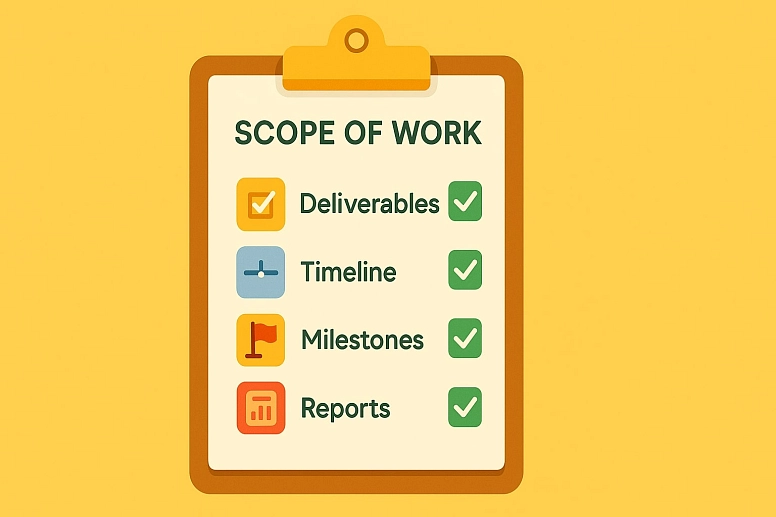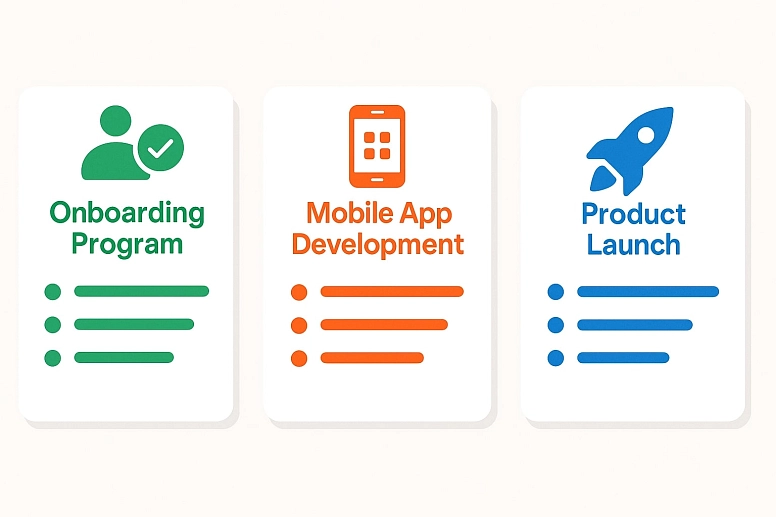How to Write a Scope of Work (With Examples and Template)
- Scope of Work Meaning
- What to Include in the Scope of Work Document
- What is a Scope of Work Template?
- How to Write a Scope of Work Template
- How Do You Write a Scope of Work?
- Scope of Work Examples
- Why Is Writing a General Scope of Work Important?
- How to Create a Scope of Work Document - 4 Tips
- Bottom Line
If you’re wondering what’s a scope of work, it’s exactly what you’re going to do for your customer or client. Simply put, when you create this project outline, you need to include not only what you will do but also the materials, the responsibilities of everyone involved, the timeline, and all the steps needed to get the job done as part of your project management process.
If you’re a perfectionist, you’re going to love a work scope. After all, with this tool, there aren’t any misunderstandings about the project since everything is specified in detail. Below, you’ll find examples of scope of work and learn how to write a scope of work document.
Scope of Work Meaning
While we’ve touched on what a scope of work is, it’s worth digging a little deeper. Let’s break it down properly, one step at a time.
A scope of work is simply a document that lays out every detail of a project—from the tasks to the deadlines to who’s responsible for what. Just to give you an idea, many businesses use it when they’re putting together a service proposal for customers or clients or outlining project management workflows. It helps customers feel secure because they know exactly what they’re getting, how they’re getting it, and when they’re getting it from you. If you think about it, a project outline lets your potential client see exactly what you’re offering—and set their expectations from the start.
When in doubt about whether to include a detail—include it.
What to Include in the Scope of Work Document
When you’re putting together a scope of work—or even a rough draft—you want to be sure you’re covering the important stuff. Think about the small things that could cause confusion later if you don’t spell them out now. It’s always better to be too clear than not clear enough. To help you cover your bases, here are a few important pieces you’ll probably want to include. Of course, you can tweak the list based on what your project actually needs.
Pro tip: If you want an easier way to manage your scope of work details, you can organize everything—from deliverables to timelines to reports—directly inside a project management platform like Flowlu. It helps you keep tasks, milestones, and client expectations aligned without needing multiple documents.
#1: Deliverables:
The deliverables are the number one reason for the project. Simply put, it’s what you’ll deliver to the client at the end.
Keep in mind: the deliverable can be anything—a document, a piece of software, a product, a report, or something else entirely. You just need to make it clear here as part of your project management process.
#2: Timeline:
When you’re putting together your scope of work, don’t forget the project timeline.
Map it out from kickoff to final delivery.
Breaking the project into clear phases or steps makes everything easier to track—and way easier to manage later with your project management tools.
If you want to make your timeline even stronger, add a visual.
Something simple, like a Gantt chart, can help everyone see the bigger picture and know exactly what’s coming next.
#3: Milestones:
If you’ve been around project work for a while, you already know how much milestones matter—especially when a project starts getting bigger and a little more chaotic from a project management perspective.
If you’re newer to larger projects, here’s a tip:
Set a milestone every time you wrap up a major phase.
It’ll make it easier to track progress and catch problems before they snowball. It’ll make tracking progress way less stressful.
#4: Reports:
Reports are a big part of keeping everyone on the same page.
Be clear about what reports you’ll send, how often you’ll send them, and what they’ll actually cover.
And when we say "reports," we’re talking about all kinds—variance reports, progress updates, status check-ins, whatever fits the project.
Pick the ones that make the most sense, and spell it out clearly so nobody’s left guessing.
What is a Scope of Work Template?
A scope of work template is exactly what it sounds like: a ready-made document you fill in with your project’s details. It’s there to save you time—and help you make sure you don’t leave anything important out when you’re putting everything together.
How to Write a Scope of Work Template
Instead of walking you through how to build one from scratch, we’re handing you a free template to make life easier.
Here’s a simple outline you can follow to put together a solid SOW:
- Project Name or Title: The official name of the project.
- Parties Involved: List everyone involved in the project.
- Introduction: Briefly describe the kind of work each party will complete.
- Goals & Objectives: Include background information and context about the project's main purpose.
- Scope of Work: List all the project’s objectives clearly.
- Task List: Describe exactly what each team member is responsible for.
- Project Schedule: Be specific about the timeline. Break the project into phases, add your deadlines, and drop in milestones if you’ve set them. The more organized your schedule is upfront, the smoother everything will run later in your project management workflow.
- Project Deliverables: Make a clear list of everything you’ll deliver by the end of the project. Be specific. The more details you nail down now, the fewer questions (and headaches) you’ll deal with later.
- Project Costs: Lay out a full budget that covers all the expected fees and expenses.
- Don’t forget the extras—materials, labor, software, and anything else the project might need to stay on track.
Instead of juggling all these pieces manually, you can manage everything in Flowlu—your all-in-one project management platform.
Create tasks, set deliverables, track budgets, and map out your project timeline—all in one spot, without the usual back-and-forth.
How Do You Write a Scope of Work?
Even though we’ve already walked through the key parts of a scope of work, these next steps will help you double-check that nothing important slips through the cracks in your project management process.
Step #1: Set the Goals
Before you even start writing, set the goals for the project—the outcomes you need to accomplish by the end.
Step #2: Identify Tasks
You’ll need to break the project down into smaller, manageable tasks. That’s where a WBS—short for work breakdown structure—comes in. It’s a simple way to organize the work so it’s easier to plan and track. It’s a simple tool that organizes everything into clear steps and makes scheduling a whole lot easier for project management.
Step #3: Determine the Deliverables
As we mentioned earlier, project deliverables are the final product you’ll deliver. These can be tangible or intangible—and they’re the result of all the tasks you identified in the previous step.
Step #4: Define the Acceptance Criteria
Your deliverables need to meet certain standards—like functionality requirements or quality benchmarks. Set these expectations clearly here.
Step #5: Create the Project Timeline
A clear timeline is one of the best ways to keep a project on track. Many project managers use the CPM—short for critical path method—to map out the most efficient order of tasks and get a better sense of how long everything will take.
Step #6: Establish the Payment Terms
As you’d expect, this is where you lay out all the payment details. Be specific. List the payment schedule, accepted methods, due dates, and any late fees or penalties. Getting this in writing early keeps expectations clear and avoids messy conversations later on.
Step #7: Set the Reporting Procedures
You already know how important good communication is with your stakeholders. In this section, lay out what kinds of reports you’ll send—and when they’ll go out.
Scope of Work Examples
Now that you know what to include—and you’ve seen a template—it’s time to look at some real examples. We’ll walk you through a few different SOWs so you can see exactly how to write a SOW from start to finish.
#1: Simple Scope of Work Example: Employee Onboarding Program
- Objective: Help new hires get comfortable fast and feel like part of the team from day one.
- Scope: Create training materials, build an onboarding checklist, run orientation sessions, and gather feedback to keep improving the process.
- Timeline: 3 months to complete, including revision and evaluation periods.
- Deliverables: Training materials, onboarding manual, and feedback report.
- Dependencies: Availability of new hires, cooperation from different departments, feedback from new employees, and timely input.
#2: Project Scope of Work Example: Development of a Mobile App
- Objective: Design and build a mobile app for food delivery that’s easy to use and packed with must-have features like multiple payment options, live tracking, and more.
- Scope: Develop a cross-platform app for Android and iOS. Handle the full process, from UI/UX design to backend development, thorough testing, bug fixing, and final deployment to the app stores.
- Timeline: 4 months from kickoff to launch, with key milestones mapped out along the way.
- Deliverables: Mobile app, source code, user manual, and test report.
- Dependencies: Availability of resources, stakeholder approvals at each milestone, and access to third-party payment gateways.
#3: Detailed Scope of Work Example: Launching a New Product
- Objective: Plan and launch a marketing campaign to drive the rollout of a new product.
- Scope: Dig into competitor research, study the market, create marketing materials, manage PR outreach, run promotions across social media, and track the campaign’s performance from start to finish.
- Timeline: 2 months to complete, with milestones included.
- Deliverables: Complete marketing strategy and promotional content for press releases, social media posts, blogs, and more. Includes a final report measuring campaign impact.
- Dependencies: Collaboration with influencers, approvals and feedback from stakeholders and the product team, and market response.
Why Is Writing a General Scope of Work Important?
While you may already know some of the benefits of having a clear SOW document—or even a simple project outline letter—there are a few key reasons worth highlighting for effective project management.
#1: It Defines the Project Scope
A good SOW lays the project out clearly—no guessing, no assumptions. It lays out exactly what’s being delivered—and just as importantly, what’s not—so everyone knows what to expect from the start.
#2: It Helps Prevent Scope Creep
Scope creep can sneak into any project, no matter the size.
It usually happens when extra tasks get added after the work’s already underway—pushing timelines, blowing up budgets, and draining resources.
A clear scope makes it easier to stay focused, catch changes early, and keep the project from drifting off course.
#3: It Sets Clear Expectations
One of the best things about a solid SOW: no one’s left guessing.
When roles, deadlines, and deliverables are laid out clearly, it’s a lot easier to keep the project running smoothly through your project management system—and avoid last-minute surprises.
How to Create a Scope of Work Document - 4 Tips
#1: Be Specific
This can’t be said enough: when you’re writing a scope of work, the details matter.
The more you spell things out, the easier it is for everyone involved to know exactly what’s expected—and the less chance there is for confusion later.
#2: Use Visuals
Visuals aren’t just helpful for timelines—they can make the entire scope easier to digest.
Don’t be afraid to add charts, diagrams, or simple graphics wherever they can bring clarity. Sometimes one good visual can save a whole lot of explaining.
#3: Get the Document Signed
A scope of work—or a scope of duties—only holds real value once it’s signed by everyone involved. Make sure you get signatures before moving forward to avoid any disputes later.
#4: Use a Scope of Work Example
Writing a SOW from scratch can be time-consuming. Even if you know exactly how to structure it, using a SOW example—like the ones we shared above—can save you time and effort while helping you stay on track.
Bottom Line
By now, you should have a solid grasp of how to draft a scope of work—and how to turn it into a full proposal. We’ve covered all the essentials, shared a ready-to-use template, and walked through real examples to help you pull it all together. A strong project outline keeps expectations clear and teams aligned, making every project easier to manage from start to finish.
Need help turning your scope of work into a living, breathing project plan? Flowlu can help you turn your SOW into actual tasks, timelines, milestones, and reports—keeping everything (and everyone) on track from start to finish.
Make sure to include the main elements: objectives, scope, deliverables, schedule, payment terms, pricing, and acceptance criteria.
Not exactly. Each industry has its own specifics. You can absolutely use a scope of work example for inspiration—but you’ll need to adapt it to fit your project. For instance, industries like construction might require more visuals and technical details than others.
Yes. Some best practices include:
- Avoiding jargon,
- Being as detailed and clear as possible,
- Setting benchmarks to measure project progress,
- Involving the entire team during planning.

















